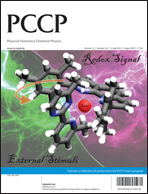Atmospheric reactions on electrically charged surfaces
Abstract
It is proposed that tropospheric NO2 at concentrations in the parts-per-billion range can be efficiently converted to HONO in a dust storm, by a process that is initiated by electron capture by NO2 from a negatively-charged dust particle. The electron capture is visualized as a harpoon-type process that does not require the NO2 to be adsorbed on the particle. The resulting electronically excited [NO2−]* ion reacts with water to form an HONO molecule plus an OH−·(H2O)n cluster ion. It is suggested that analogous processes can occur on other atmospheric aerosol particles with both positive and negative charges, with other molecules of high electron affinity such as SO2, and also, because the earth’s surface is effectively the negative plate of a planet-sized capacitor, at the surfaces of terrestrial solids, lakes and oceans.


 Please wait while we load your content...
Please wait while we load your content...